Japanese robot destroyer
As one Internet user wittily noticed, the difference between us and the Japanese is that we try to pretend to be smart, and they are stupid.
With such a note, a review of the Japanese Murasame destroyers and their close relatives, the Takanami, should begin.
One of the largest families of missile destroyers with a total of 14 units.
9 “rains” and 5 “waves”. Such poetry is played out in their names.
This is not just lyrics. Murasame is the first ship in the world equipped with an active phased array (AFAR) radar.
The Japanese are extremely reluctant to share information about their military equipment. Therefore, we always so suddenly learn about the real achievements and capabilities of their Navy.
In official press releases, Murasame is modestly referred to as general purpose escort destroyers. Pointing in a new line that thanks to a very perfect appearance and universal arms ships of this type play an important role in naval operations.
The destroyer project was approved in 1991. The lead Murasame was laid down in 1993 and put into service in 1996.
In parallel, the construction of large (9500-ton) Congo destroyers with the Aegis system was underway in Japan. The smaller and weaker armed Murasame looked against their background as an obvious step backwards.
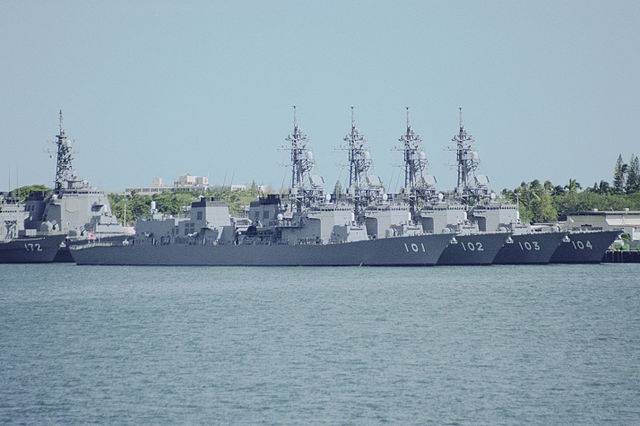
Surrealism: “Heavy rain”, “Spring rain”, “Evening rain” and “Drizzling rain” occupied all the piers of Pearl Harbor. In the background, you can see a huge "burke-shaped" destroyer - the flagship of the compound
But the Japanese saw the situation differently.
They were given priority access to the best technology; they are the only ally that the Americans took seriously.
As a result, the Japanese destroyer with the Aegis was laid down before the first Arly Burke managed to enter service.
But the Japanese did not abandon their intentions to build ships on their own projects, the design of which contained not only modern solutions, but also took into account all the features and preferences of the Japanese Navy.
The industry was not able to create its own destroyer, surpassing the licensing project in those aspects where the potential of Aegis was revealed. And this was not the task at that time. Everything needed to build missile defense destroyers was already available. Using the technologies obtained, the Sasebo, Maizuru and Yokosuki shipyards quickly laid four 9500-ton “Congos”, which got their name by no means in honor of the African state.
The next one required a universal warship to solve problems for which the large destroyer with the Aegis was clearly redundant (for example, anti-submarine defense). The "national" destroyer, which could become a test bench for working out all the trends, concepts and solutions inherent in the shipbuilding of the 1990s.
Dagger and long spear
From a combination of the flagship “Congo” and the “escort” destroyer “Murasame”, it was supposed to form combat groups in which the flagship, designed for long-range combat (air defense-missile defense), covered the formation of destroyers whose weapons were “sharpened” for close combat.
Actually, the concept is not new. At all times, the Japanese maritime password sounded the same: "eight to eight."
In the early 1920s, this meant an intention to have a fleet of 8 battleships and 8 battlecruisers. As a result, the score is 8: 8 in favor of the Japanese Navy. The plan could not be implemented.
In the 1970s and 1980s, eight-eight began to mean eight battle groups consisting of eight ships. Typical composition: PLO helicopter carrier, a pair of air defense destroyers and 5 “ordinary” destroyers. In practice, it looked quite primitive. Japan at that time did not possess naval weapons of the required level.
In the 1990s, the composition of the battle groups changed to Aegis, guarding the smaller destroyers built on their own Japanese projects.
"National" projects for the sophistication of their designs were not inferior to their "import" counterparts.
Sensei Murasame looks modern even now, and 30 years ago it was a glamor of high technology.
Japanese shipbuilders were among the first to implement a layout with under-deck placement of weapons and used a design with inclined surfaces of the superstructure to reduce the radar visibility of ships.
The generic sign of the destroyers was not the most common feed tip. The Japanese do not tolerate straight lines! It is called Oranda-zaka, "the house on the slope." The goal is to increase the safety of takeoff and landing operations. Everything that is located aft and is not a helipad in that place goes downhill. To prevent the propeller blades from touching the mooring devices or the upper deck guard.
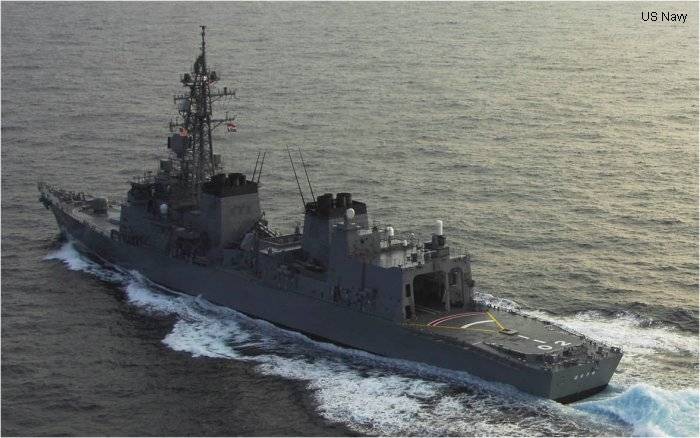
Outwardly, the destroyer makes a good impression. Each of its elements is made with special attention. But his true military qualities are hidden deep inside.
In the early 90's. on the basis of foreign-made components, the Japanese managed to create their own BIUS, linking together all the fighting posts of the ship. In the West, such systems have received the designation "C4I" (the first letters: "command", "control", "communication", "computers" and "intelligence"). In a broader sense, destroyers of the Murasame type were among the first in the world to receive a combat information system of this level.
As for reducing visibility, the inclined surfaces of the add-ons undoubtedly give Murasame a modern look. As for the real benefits, the main radio contrast element of the Japanese destroyers was and remains a massive foremast, representing a metal truss structure hung with antenna devices.
Massiveness is a tribute to Japanese ideas, according to which the design must withstand the storm conditions of the northern latitudes.
As for the need for the mast itself, at the time of the creation of the Murasame, the Japanese did not yet have their own radar with fixed antennas (PAR) mounted on the walls of the superstructure. A similar FCS-3 system will be introduced only in 2007.
FCS-3 is a European designation. The original Japanese name cannot be pronounced. FCS-3 just means “fire control system”, the third Japanese development in the field, of which anything is known.
As for Murasame, their fire control system is known as FCS-2.
Another remark will be devoted to the deck placement of weapons. Murasame missile ammunition is indeed located in individual UVP cells, implying their presence below the deck. But there is one caveat. 16 UVP sterns are placed OVER the deck. How? In the most obvious way: delivered in the form of a box. But why? Obviously, there was not enough deck space. Yes, it looks very strange (to be honest, it looks extremely suspicious). The world's only modern project with a similar placement of weapons. I remember stories from the past, when our eastern neighbors unexpectedly changed the composition of the armament of the ships from the “peaceful option” to the “military”, dumbfounding their adroitness. Something with Murasame is unclean ...
On the technical side, Murasame is as “imported” as its counterpart “Congo”. But if Congo is a copy of a foreign project, then Torrential Rain contains only individual nodes of foreign origin. Which are selected in accordance with Japanese ideas about the beautiful.
The COGAG combined destroyer propulsion system consists of four gas turbines: a pair of American GE LM2500 and a pair of Rolls-Royce Spray - a British heritage.
Of course, only technical documentation was brought from England. Industrial corporations Ishikawajima and Kawasaki back in the 1970s. mastered the licensed production of gas turbine power plants needed for warships.
But a lot of things were brought from the USA. For example, missile weapons - vertical launchers (4 modules, 32 cells). And to them in addition - arms control consoles. The Murasame Combat Information Center was created in the image and likeness of the Aegis destroyer BIC. EW tools were copied (SLQ-32 complex). Phalanxes and torpedoes purchased.
It was not possible to copy only a ship radar with AFAR technology due to the absence of such devices anywhere in the world in 1996.
One of the key features of the destroyer was its automation.
Despite the presence on board the Murasame full range of weapons and means to counter surface, underwater and airborne threats, the number of its crew, according to open sources, is only 165 people.
If the figures given are true, then the Japanese destroyer was the absolute leader in automation among ships of its era. In the 1990s, only the most primitive frigates had such a crew size, half the size of the Murasame and had a much more compressed armament (for example, the French Lafayette - 160 crew).
Since we are talking about sizes ... According to modern concepts, the displacement of Murasame is somewhere on the upper boundary for the class "frigate" and on the lower bar for the class of destroyer. 6200 tons of full displacement with a hull length of 151 meters.
Typical dimensions for a ship in the ocean. It will not be entirely correct to call them modest “workhorses” fleet.
Taking into account all the forces expended on them and a high level of technical performance at the time of their appearance, these were real “horses.”
In total, it was planned to build 14 such destroyers, but only 9 were built. No, the rest were not “shifted to the right” and then deleted from the lists in favor of “optimizing” the budget.
They were completed in 2000-2006. on the improved Takanami project.
"High Wave" is almost a complete analogue of "Heavy Rain." The same sizes. The same silhouette - with a smoothly curved forecastle and an Oranda-zaka platform in the aft. A superstructure of the same shape and a massive mast, in front of which a radar with AFAR is installed. Identical power plant and almost unchanged composition of weapons.
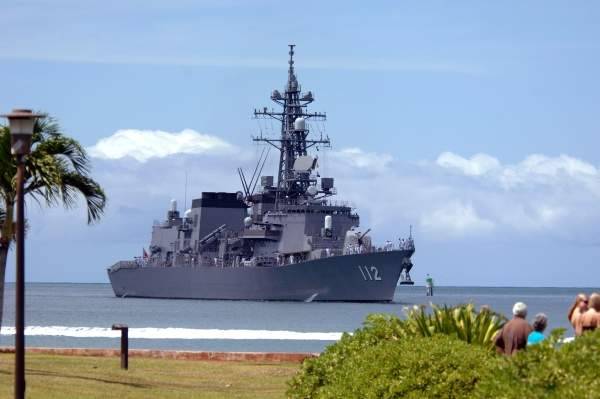
Outside, to distinguish “Murasame” and “Takanami” is possible, probably, only for enthusiastic modelers.
The main change was the refusal to place part of the UVP on the deck, in the middle of the hull. All 32 Takanami missile silos were located in the bow, in front of the superstructure.
But what remains on the site of “boxing”? Nothing. Empty box. Here we will not draw far-reaching conclusions, but throughout the Takanami (as well as the Murasame, which has only 16 air-guided missiles in the bow), they are underutilized and have reserved volumes for increasing missile ammunition or installing combat modules.
Another change is the increase in the caliber of a universal gun mount from 76 to 127 mm. However, for a modern ship this is of very little importance.
The rest of the armament is the same, corresponds to Murasame.
Two main search radars, two anti-aircraft fire control radars, a hinged sonar and a towed low-frequency antenna.
32 launchers: sources call 16 anti-submarine missiles and 64 anti-aircraft missiles ESSM. From 4 to 8 Type 90 anti-ship missiles. A pair of "Phalanxes". Small torpedoes. Helicopter.
Of course, when we have before us a series of 14 ships built over 13 years, then there can be no talk of any complete unification. This is especially true of the combat information system and fire controls - the most complex elements of the ship; the changes made in them can be considered almost the creation of a new project.
The first three and two last “Takanami” have noticeable differences in the composition of the elements of the CIU. In this sense, the first representatives are more similar to Murasame. In turn, the last two, “Swell” and “Cool Wave”, also differ from each other.
2050 is closer than 1990
"Murasame" / "Takanami" for the Japanese is not the past, but the year before last.
In the 2010s our eastern neighbors “stuck” another 6 very distinctive destroyers of a new generation, which surprised everyone. What is their radar complex, consisting of eight AFAR!
Six multipurpose destroyers, not counting the "golden eagle" flagships and helicopter destroyers.
Then this calculation begins - next year, the last, eighth flagship destroyer, the Haguro, will be accepted into the Japanese Navy's self-defense. And on this 30-year-old ambitious program "eight-eight" can be considered completed.
The future of the Japanese fleet is hidden in a veil of paranoid secrecy. It is only known that in general the concept of battle groups will remain the same. But the next generation of destroyers will get a completely different look and new layout. Details? You can’t wait from the Japanese.
However, the year 2050 is already closer than the 1990th. Therefore, very soon the details will become known. When you accidentally manage to photograph the hull of destroyers under construction in a high degree of readiness.
As for the consequences for Russia from this unrestrained Japanese militarism ... If ever our Navy has to clash with this armada, I would not want the words of the commander of the EDB "Emperor Alexander III" to be heard again: "I vouch for one thing: we will die, but we will not give up ... ”(episode at a farewell banquet from the legendary book of A. Novikov-Priboy).
They all lack moorings, so destroyers are moored in rows. From behind the back of the destroyer of the Murasame type, an add-on of another ship sticks out - with a double phased antenna (white squares). New generation destroyer!
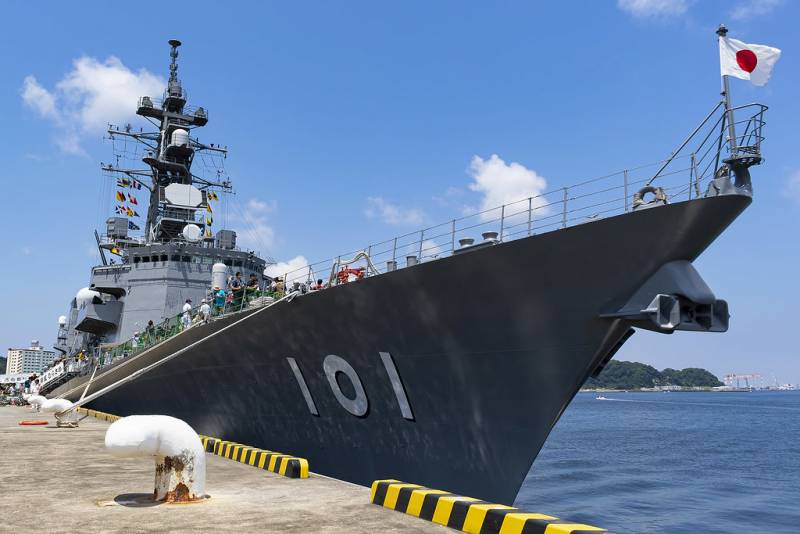
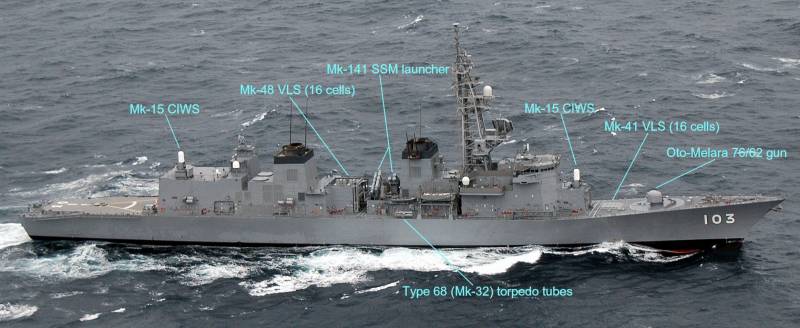
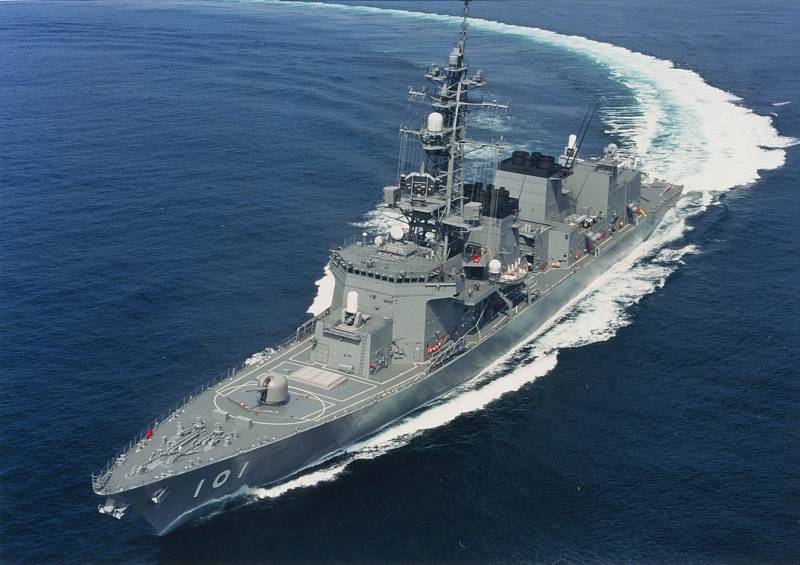
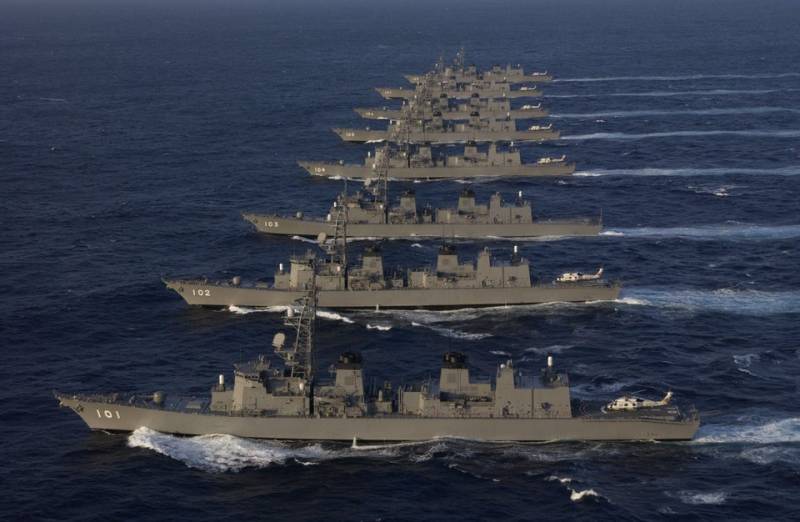
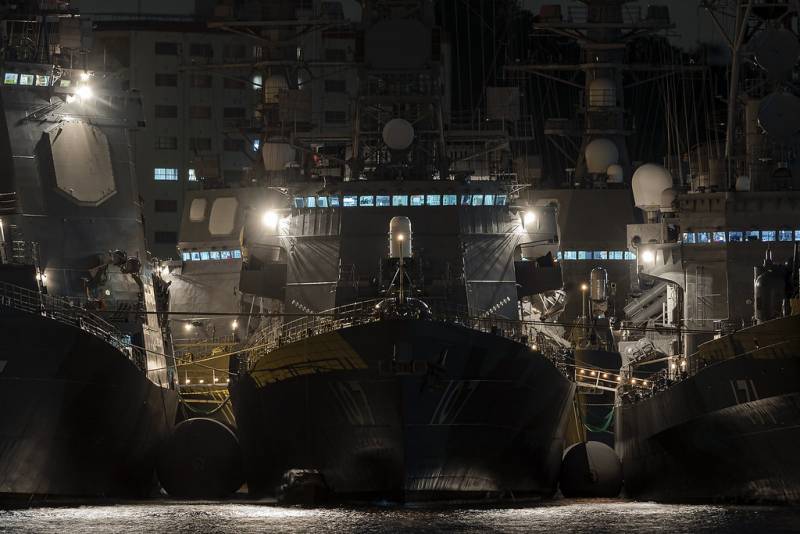
Information